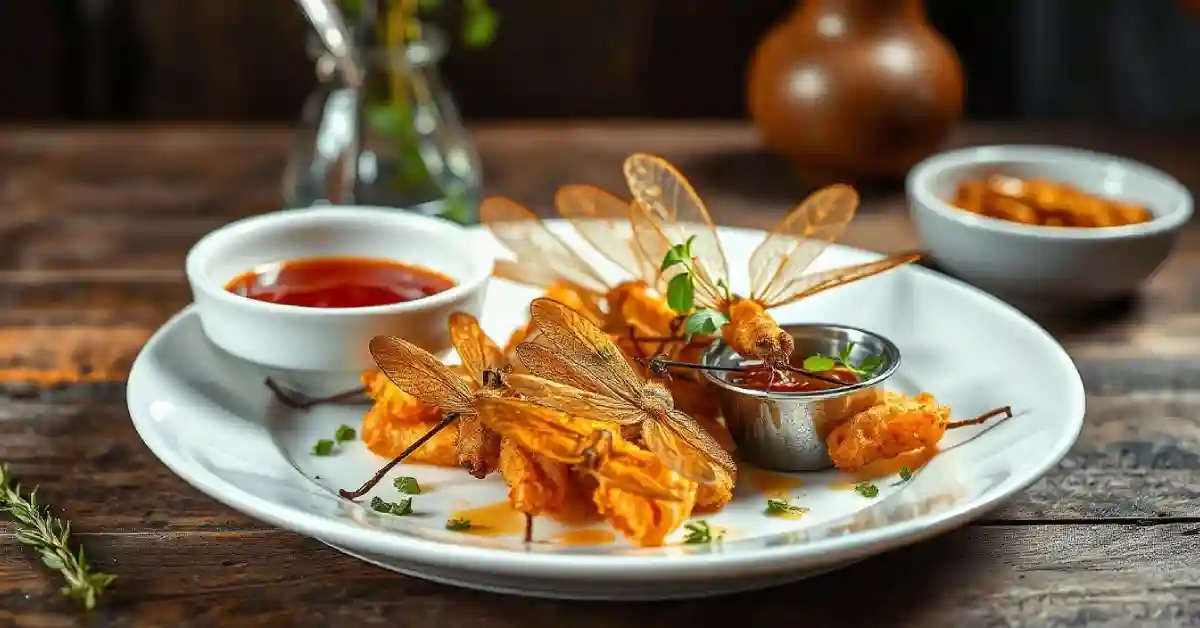Have you ever considered the intricate dance between entomology and culinary arts? The bugtrapper’s fried dragonfly offers a surprisingly tasteful plunge into this realm. For enthusiasts and experts alike, it poses a fusion of conservation and curiosity on your plate.
Historically, dragonflies were revered in many cultures as symbols of change. Today, transforming them into a culinary delight might seem unorthodox, yet the practice has roots in sustainable protein alternatives. With bug populations decreasing globally, your careful preparation of fried dragonfly ensures you’re supporting eco-friendly gourmet choices while indulging in adventurous flavors.
Decoding Bugtrappers Fried Dragonfly: A Delicacy?
Bugtrappers’ fried dragonfly is not your typical dish. This unique delicacy surprises many with its origins in ancient culinary traditions. Dragonflies have been part of some cultures’ diets for centuries, cherished for their crisp texture. They can be found delicately fried, offering a crunchy bite and a mild flavor. Yet, not everyone is willing to take the plunge and try this intriguing dish.
Becoming a popular dish involves understanding both tradition and taste. Bugtrappers carefully select dragonflies, ensuring they are safe for consumption. Then, they’re expertly cleaned and prepped, often marinated in a blend of local spices. Cooking techniques can vary, but frying often enhances the dragonfly’s natural crunchiness. This process requires skill and patience, resulting in a dish that intrigues the adventurous eater.
Why consider tasting a dragonfly? For one, they’re a sustainable protein source, adding an eco-friendly option to your diet. Moreover, they carry nutrients like protein and omega-3 fatty acids. Imagine replacing meat with these tiny powerhouses in your meals. People curious about alternative foods might find dragonflies a fascinating alternative. As interest in sustainable foods grows, this could be a new frontier in dining.
Some people approach bugtrappers’ fried dragonfly as a means to expand their culinary horizons. By embracing insects as food, they connect with global eating practices. The unique textures and flavors challenge conventional eating habits. Restaurants and food enthusiasts who focus on sustainability see this as a chance for innovation. Dare to taste, and you might discover an unexpected culinary adventure.
The Historical Significance of Dragonfly in Cuisine
Dragonflies have been more than just insects fluttering by for many cultures. In Southeast Asia, for instance, dragonflies were commonly used in meals centuries ago. They were not only a nutritional source but also a delicacy relished by many. Their presence in cuisine signaled both resourcefulness and a connection to nature. Such historical ties highlight the versatility of food sources.
Exploring traditional diets reveals the dragonfly’s unique place at the table. In countries like Japan and Indonesia, these insects were caught during specific seasons. This practice ensured a sustainable approach to consuming natural resources. It wasn’t unusual to see them offered at local markets as a crunchy snack. These traditions showcased a deep understanding of seasonal biodiversity.
Culinary customs involving dragonflies underscore the importance of local food practices. Many cultures developed specific cooking methods to highlight their distinct flavor. By frying or roasting, the sweetness and nuttiness of dragonflies were enhanced. Their role in culinary heritage shows a world of flavors beyond common ingredients. Hence, they continue to stir curiosity among food historians and chefs today.
The historical journey of dragonflies in cuisine brings to light the evolution of food across cultures. As global interest in sustainable eating grows, these dynastic practices hold lessons for modern eaters. Celebrated chefs and adventurous home cooks are revisiting these recipes with renewed interest. By doing so, they not only respect traditions but also innovate for a sustainable future. Dragonflies may once again find their way into contemporary menus, bridging past and present.
The Art of Bugtrapping: More than a Hobby
Bugtrapping is a fascinating pursuit that marries science and adventure. For some, it’s simply a way to connect with nature and observe insects up close. However, others take bugtrapping further, contributing to scientific research and environmental conservation. By cataloging various species, bugtrappers provide valuable data on insect populations. This practice is vital in understanding ecosystem changes over time.
Though it starts as a hobby, bugtrapping requires patience and skill. Enthusiasts often spend hours perfecting their techniques to catch insects safely and ethically. They use special tools like nets, jars, and even homemade traps. Studying the habits and habitats of insects helps improve their catches. It’s both a mental and physical challenge that offers rewards beyond the usual pastime.
Bugtrapping also fosters a deeper appreciation for the smaller creatures that often go unnoticed. By observing different species up close, enthusiasts learn about their behavior and roles in the environment. This knowledge can inspire advocacy for insect conservation. Understanding these roles is crucial as insects are vital to pollination and as food for other animals. Bugtrapping becomes a window into an interconnected world.
As technology advances, the tools and methods for bugtrapping are evolving. Mobile apps and digital photography make it easier to identify and log finds. Online communities allow bugtrappers to share experiences and discoveries. This camaraderie enhances the hobby, turning individual efforts into a collective movement. For many, bugtrapping isn’t just an activity; it’s a pathway to understanding and protecting our natural world.
Preparing Fried Dragonfly: Key Tips and Techniques
Frying dragonflies might sound unusual, but it’s a culinary practice steeped in tradition. To start, you’ll need fresh dragonflies, preferably caught same day for peak freshness. Rinse them gently under cold water to remove any dirt and debris. Then, pat them dry so they don’t splatter when frying. Cleanliness is essential to prevent any unwanted flavors.
Once cleaned, marinating the dragonflies enhances their taste remarkably. Use simple ingredients like soy sauce, ginger, and garlic for a savory marinade. Let them soak for at least 30 minutes to absorb the flavors well. This mixture can be adjusted according to your taste preferences. Marination adds depth and complexity to the dish.
For a crispy finish, coat the dragonflies lightly in a seasoned flour or batter mix. Here are some common coatings you can use:
- Flour mixed with chili powder and salt for a spicy kick.
- Cornmeal for a crunchier texture.
- Tempura batter for a light, airy crunch.
Choose the one that suits your palate best.
Heating the oil to the right temperature is crucial for a successful fry. Heat it to about 350°F (175°C) before adding the dragonflies. Fry them until they turn golden brown, which usually takes just a couple of minutes. Remove them with a slotted spoon to drain excess oil. Serve immediately for the best crunch and flavor.
Pair your fried dragonflies with a dipping sauce for an added flavor boost. Options like soy sauce, wasabi mayo, or sweet chili sauce work well. These sauces complement the dragonfly’s unique taste. Arrange them neatly on a serving plate for an appealing presentation. Encourage your guests to try something new and adventurous.
Appreciating Bugtrapper Cuisine: Sustainability and Gastronomy
Embracing bugtrapper cuisine taps into a world where food meets sustainability. Many chefs and home cooks are turning to insects like dragonflies as eco-friendly food sources. They require less land and water to farm compared to traditional livestock. This shift not only reduces environmental impact but also introduces diverse flavors to modern plates. It’s a delicious solution for a greener planet.
Sustainability in gastronomy involves using resources mindfully. Insects, abundant in nature, present a promising alternative. They are rich in protein, vitamins, and amino acids, all essential for a healthy diet. With the global population rising, sustainable foods like these become more critical. Utilizing insect cuisine aligns with efforts to promote responsible eating habits.
Chefs championing bugtrapper cuisine often delight in experimenting with various cooking techniques. From frying to sautéing, each method brings out a different aspect of the insect’s flavor. Innovative recipes showcase how versatile these ingredients can be. Such creativity helps break down barriers of cultural hesitance. By tasting bugtrapper dishes, diners discover new culinary perspectives.
For the adventurous eater, accepting bugtrapper cuisine can be a thrilling journey. Tasting these unique dishes expands your palate while supporting sustainable agriculture. Here are some reasons bugtrapper cuisine is gaining popularity:
- Minimizes carbon footprint.
- Offers high nutritional value.
- Encourages biodiversity conservation.
Every dish tells a story of its ingredients and their origins.
As more kitchens incorporate bugtrapper dishes, the narrative around food sustainability grows richer. The movement encourages people to rethink traditional dining. It’s about embracing global flavors while being conscious of our environmental choices. By doing so, the fusion of sustainability and gastronomy can inspire generations of thoughtful eaters. Explore a world where taste and ecology walk hand in hand.
Concluding Thoughts on Bugtrapper Cuisine and Sustainable Practices
As you delve into the world of bugtrapper cuisine, you’ll uncover the delicate balance between tradition and innovation. The practice of using fried dragonflies not only evokes rich historical narratives but also challenges your palate. Its potential lies in embracing global flavor diversity while advancing sustainable food practices.
Your journey through this unique culinary landscape highlights the essential role such cuisines play in sustainable gastronomy. By experimenting with bugtrapper dishes, you contribute to an evolving dialogue around responsible eating. Together, we can create a future where culinary curiosity intersects with environmental stewardship for a truly impactful experience.
Frequently Asked Questions With Answers
What is bugtrapper’s fried dragonfly?
Bugtrapper’s fried dragonfly is a unique culinary dish made from dragonflies that have been carefully trapped, cleaned, marinated, and fried. It is a sustainable protein source enjoyed by adventurous eaters who want to explore eco-friendly cuisine.
Why should I consider eating fried dragonflies?
Eating fried dragonflies offers a sustainable protein option with high nutritional value. They are rich in protein, omega-3 fatty acids, and other essential nutrients. Consuming them supports environmentally friendly food practices.
How do I prepare fried dragonflies?
To prepare fried dragonflies, clean them thoroughly, marinate them in a mix of spices like soy sauce, ginger, and garlic, then lightly coat them in flour or tempura batter. Fry at 350°F (175°C) until golden and crispy, then serve with dipping sauces for added flavor.
Are fried dragonflies safe to eat?
Yes, fried dragonflies are safe to eat as long as they are properly cleaned, marinated, and cooked. Bugtrappers ensure that the dragonflies are carefully selected and safe for human consumption, following ethical practices for sustainable eating.
What makes bugtrapper cuisine sustainable?
Bugtrapper cuisine, such as fried dragonflies, is sustainable because insects require fewer resources like land and water compared to traditional livestock. They also have a lower carbon footprint, making them an eco-friendly food choice that promotes biodiversity conservation.

